Universal Tools
All students may access features of the assessments that are provided either as digitally delivered components of the TDS (embedded) or separate from it (non-embedded) based on student preference and selection. For example, global notes is an embedded universal tool; scratch paper is a non-embedded universal tool.
Embedded
Embedded universal tools are available within the computer-based TDS to all students. They are also available to test examiners who are entering student responses to the CAA and the Alternate ELPAC test questions on behalf of students unable to provide responses on their own in the TDS.
Breaks (Computer-based Assessments)
Approved Assessment(s):
- All (computer-based assessments)
Description:
A student selects the [Pause] button, indicated in figure 1, within the test to take a break from testing.

Figure 1. Breaks—[Pause] button
- Breaks of more than 20 minutes will prevent the student from returning to questions already attempted by the student.
- There is no limit on the number of breaks that a student might be given.
- The use of this universal tool may result in the student needing additional overall time to complete the assessment.
- A review screen at the end of each test segment prompts a student to review the answers in that segment. When administering the CAST over multiple sessions, it is recommended that the test be paused at the end of a test segment.
For the CAAs for ELA, mathematics, and science as well as the Initial Alternate ELPAC and Summative Alternate ELPAC, the test examiner can make the decision to pause and resume the test administration if the student is no longer engaged, is not actively participating, or is showing signs of behavioral or functional concerns related to the test. The test can be paused and resumed as many times as necessary to allow the student to show what the student knows. If the choice is made to pause the test, the student can reenter and complete testing on the same day or at a later time.
For the Initial ELPAC and Summative ELPAC, the following rules apply:
- Breaks may be used between domains.
- For Listening and Reading domains (but not the Speaking and Writing domains), breaks of more than 20 minutes will prevent the student from returning to questions already attempted by the student.
- Breaks may only be used in the middle of a domain if a student has a documented need to take extended breaks. This is an accommodation and must be selected in TOMS.
Calculator, Mathematics (Selected Items)
Approved Assessment(s):
- Smarter Balanced for Mathematics (grades six through eight and grade eleven)
Description:
An embedded on-screen digital calculator can be accessed for calculator-allowed questions when a student selects the [Calculator] button. This button, indicated in figure 2, appears when such questions are accessed.

Figure 2. Basic mathematics calculator and [Calculator] button
- This universal tool is for use only on calculator-allowed questions in grades six through eight and grade eleven.
- When the embedded calculator, as presented for all students, is not appropriate for a student (for example, for a student who is blind), the student may use the calculator offered with assistive technology devices, such as a talking calculator or a braille calculator.
- A student who requires a non-embedded calculator for mathematics should be assigned to use the mathematics non-embedded calculator accommodation.
- A student can maximize the calculator so it covers the test question area—item and stem—by selecting the diagonal arrows in the upper-right corner (also indicated in figure 2). (Selecting the diagonal arrows again restores the calculator to its original size.)
- A student can resize the calculator to a selected height and width by hovering over the circle with the arrows in the lower-right corner—also indicated in figure 2—until the cursor turns into a diagonal, two-headed arrow; and then using the selection means (for example, pressing and holding a mouse button) to drag the calculator’s corner to increase or decrease the size of the calculator.
Calculator, Science (Selected Items)
Approved Assessment(s):
- CAST
Description:
An embedded on-screen digital calculator can be accessed for calculator-allowed questions when a student selects the calculator button. This button, like the one indicated in figure 3, appears when such questions are accessed.
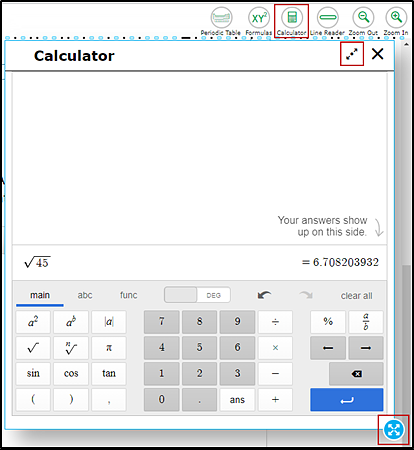
Figure 3. Scientific calculator and [Calculator] button
- When the embedded calculator, as presented for all students, is not appropriate for a student (for example, for a student who is blind), the student may use the calculator offered with assistive technology devices, such as a talking calculator or a braille calculator.
- This universal tool is for use by a student in grade five with a basic (four-function) calculator; and grades eight, ten, eleven, and twelve with a scientific calculator.
- A student who requires a non-embedded calculator for science should be assigned to use the science non-embedded calculator designated support.
- A student can maximize the calculator so it covers the test question area—item and stem—by selecting the diagonal arrows in the upper-right corner (also indicated in figure 3). (Selecting the diagonal arrows again restores the calculator to its original size.)
- A student can resize the calculator by hovering over the circle with the arrows in the lower-right corner—also indicated in figure 3—until the cursor turns into a diagonal, two-headed arrow; and then using the selection means (for example, pressing and holding a mouse button) to drag the calculator’s corner to increase or decrease the size of the calculator.
Digital Notepad
Approved Assessment(s):
- All (computer-based assessments)
Description:
This resource is used for making notes about a question. A student accesses the digital notepad by right-clicking on the test question or using the context menu (which is indicated in figure 4) and then selecting Notepad from the shortcut menu.

Figure 4. Digital notepad
- The digital notepad is question-specific and is available through the end of the test segment.
- For the CAASPP, notes are not saved when the student moves on to the next segment or after a break of more than 20 minutes.
- For the ELPAC, notes are saved after a break of more than 20 minutes on the page to which the student is returning if there are multiple items on the page.
- A student can resize the digital notepad by hovering over the circle with the arrows in the lower-right corner—also indicated in figure 4—until the cursor turns into a diagonal, two-headed arrow; and then using the selection means (for example, pressing and holding a mouse button) to drag the notepad’s corner to increase or decrease the size of the notepad.
- A student cannot copy and paste content from the digital notepad into the CR field.
- A student can use the embedded speech-to-text accommodation with this universal tool if speech-to-text is assigned as a test setting in TOMS for the student.
English Dictionary (Writing)
Approved Assessment(s):
- Smarter Balanced for ELA
Description:
An English dictionary is available for the full write (WER) portion of an ELA PT. (A full write is the second part of a PT.)
-
A student accesses the English dictionary by selecting the [Dictionary] icon during specific test segments. This button is indicated in figure 5.
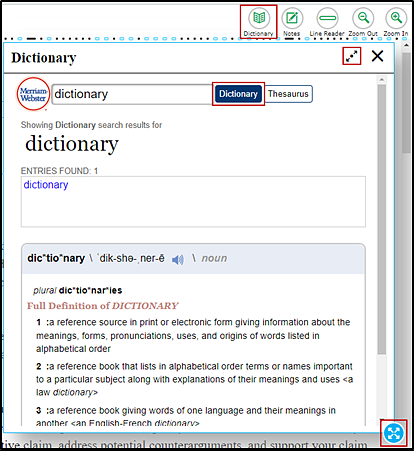
Figure 5. English dictionary
- A student must first type a word into the field next to the Merriam-Webster® logo and then select the [Dictionary] button, also indicated, to receive a result.
- The use of this universal tool may result in the student needing additional overall time to complete the assessment.
- A student can maximize the dictionary so it covers the test question area—item and stem—by selecting the diagonal arrows in the upper-right corner (also indicated in figure 5). (Selecting the diagonal arrows again restores the dictionary to its original size.)
- A student can resize the dictionary by hovering over the circle with the arrows in the lower-right corner—also indicated in figure 5—until the cursor turns into a diagonal, two-headed arrow; and then using the selection means (for example, pressing and holding a mouse button) to drag the dictionary corner to increase or decrease the size of the dictionary.
English Glossary
Approved Assessment(s):
- Smarter Balanced for ELA
- Smarter Balanced for Mathematics
- CAST
Description:
Grade- and context-appropriate definitions of specific construct-irrelevant terms are shown in English on the screen via a pop-up window. An example is shown in figure 6.
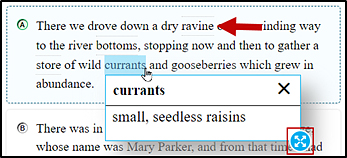
Figure 6. English glossary
- A student can access the embedded glossary by selecting any of the preselected terms, which are identified with light-gray parallel lines above and below the term. When the student hovers over the term—“currants” in figure 6—it is shaded blue; it will also have hover text that says “lookup word” (not shown). In figure 6, “ravine” is also a glossary term.
- A student can resize the glossary by hovering over the circle with the arrows in the lower-right corner—indicated in figure 6—until the cursor turns into a diagonal, two-headed arrow; and then using the selection means (for example, pressing and holding a mouse button) to drag the glossary corner to increase or decrease the size of the glossary.
- The use of this universal tool may result in the student needing additional overall time to complete the assessment.
English Thesaurus
Approved Assessment(s):
- Smarter Balanced for ELA (PT)
Description:
A thesaurus contains synonyms of terms that can be accessed while a student interacts with text included in the assessment.
- This universal tool is available on an ELA full-write (WER) PT. (A full write is the second part of the ELA PT.)
-
A student accesses the thesaurus by selecting the [Dictionary] icon during specific test segments. This button is indicated in figure 7.

Figure 7. English dictionary with thesaurus
- A student must first type a word into the field next to the Merriam-Webster® logo and then select the [Thesaurus] button, also indicated, to garner a result.
- The use of this universal tool may result in the student needing additional overall time to complete the assessment.
- A student can maximize the dictionary so it covers the test question area—item and stem—by selecting the diagonal arrows in the upper-right corner (also indicated in figure 7). (Selecting the diagonal arrows again restores the dictionary to its original size.)
- A student can resize the dictionary by hovering over the circle with the arrows in the lower-right corner—also indicated in figure 7—until the cursor turns into a diagonal, two-headed arrow; and then using the selection means (for example, pressing and holding a mouse button) to drag the dictionary corner to increase or decrease the size of the dictionary.
Expandable Items
Approved Assessment(s):
- All (computer-based assessments)
Description:
Each stimulus in the left pane and question(s) in the right pane can be expanded so that it takes up a larger portion of the screen when the student selects one of the two horizontal arrows between the passage and the question(s). The arrows are indicated in figure 8.
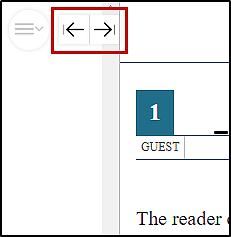
Figure 8. Expandable items
- The right arrow expands the passage or stimulus; the left arrow contracts the expanded passage or stimulus and expands the question(s). However, if the test administrator or test examiner has turned off the expandable passages universal tool, the student would see the left arrow—to expand the pane with the test item—only.
- The default setting for this universal tool is “ON” and must be toggled to “OFF” by the test administrator or test examiner on the Approvals and Student Test Settings screen for the student (select the [View] eye [
 ] icon for a student before approving the test and then set the Expandable Items toggle to “ON”).
] icon for a student before approving the test and then set the Expandable Items toggle to “ON”). -
This toggle is indicated in figure 9.
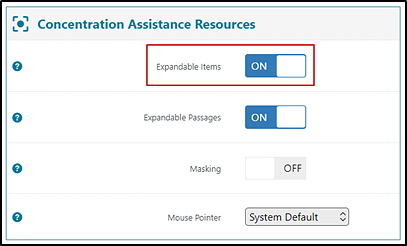
Figure 9. Test settings in the Test Administrator Interface
- For the CAAs for ELA and mathematics, the Summative ELPAC, and the Initial ELPAC, the default setting is for all items to be expandable.
Expandable Passages
Approved Assessment(s):
- All (computer-based assessments)
Description:
Each passage or stimulus can be expanded so that it takes up a larger portion of the screen when the student selects the [Expand] arrows icon, which is indicated in figure 10.
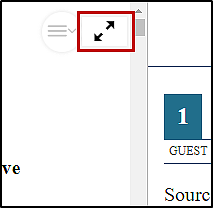
Figure 10. Expandable passages
- Select the [Expand] arrows icon to expand the passage. The icon will appear as shown only if the expandable items universal tool has been turned off. If both expandable passages and expandable items are on, the test will display with two arrow buttons as shown in figure 10.
- This universal tool expands the passage only.
Global Notes (Writing)
Approved Assessment(s):
- Smarter Balanced for ELA (PT)
Description:
The global notes universal tool is a notepad that is available for the item(s) in the ELA PT in which a student completes a full write (the second part of a PT).
-
The student selects the [Notes] icon, indicated in figure 11, for the notepad to appear.

Figure 11. Global notes
- During the ELA PT, the global notes are retained from segment to segment so that the student may go back to the notes even though the student is not able to go back to specific questions in the previous segment.
- A student can resize the global notes by hovering over the circle with the arrows in the lower-right corner—indicated in figure 11—until the cursor turns into a diagonal, two-headed arrow; and then using the selection means (for example, pressing and holding a mouse button) to drag the global notes corner to increase or decrease the size of the global notes.
- A student can use the embedded speech-to-text accommodation with this universal tool if speech-to-text is assigned as a test setting in TOMS for the student.
Highlighter
Approved Assessment(s):
- All (computer-based assessments)
Description:
Highlighter is a digital resource for marking desired text, questions, answers, or parts of these with one of four colors. Highlighted text remains available throughout each test segment. To use this tool, a student selects text and then selects Highlight Selection from the context menu (indicated in figure 12). Finally, the student selects a color, either yellow, orange, mint green, or lavender.
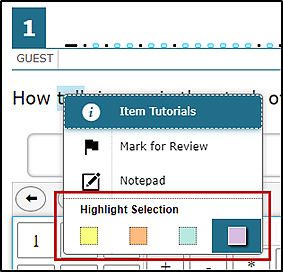
Figure 12. Highlighter
Keyboard Navigation
Approved Assessment(s):
- All (computer-based assessments)
Description:
Navigation throughout text can be accomplished by using a keyboard, rather than a mouse or other adaptive device.
Line Reader
Approved Assessment(s):
- All (computer-based assessments)
Description:
A student—alone or with the help of a test examiner (Initial ELPAC, Summative ELPAC K–2, and alternate assessments)—moves an on-screen horizontal line that surrounds each line of text with shading after selecting the [Line Reader] line button (indicated in figure 13). To move the line reader, the student selects (clicks) anywhere on the next line to be shaded or uses the arrow keys on the keyboard.

Figure 13. Line Reader
- This universal tool applies to both questions and passages.
- Selecting an answer option with the line reader universal tool also will cause an option such as a radio button or checkbox to be selected.
-
If the student selects the “Option B” radio button in a vertical list of answer options, selecting (clicking) Option B’s text will both shade the line of text in the line reader and select that answer option as the student’s response to the test question (figure 14). The student must select a line of text away from a radio button answer option—in a passage or the test question, for example—to unselect the selected line as the focus of the line reader universal tool. However, that answer option is still selected as the student’s response unless or until the student selects a different option.
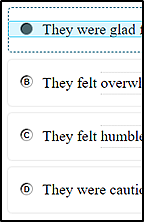
Figure 14. Line Reader with a radio button
-
If the student selects the first checkbox in a vertical list of answer options, selecting (clicking) the first checkbox’s text will both shade the line of text in the line reader and select that answer option as one of the student’s responses to the test question (figure 15). The student must select a line of text away from a checkbox answer option—in a passage or the test question, for example—to unselect the selected line as the focus of the line reader universal tool. However, that answer option is still selected as one of the student’s responses unless or until the student selects the checkbox to unselect it.
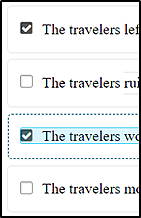
Figure 15. Line Reader with a checkbox
Mark for Review
Approved Assessment(s):
- All (computer-based assessments)
Description:
Mark for review allows a student to flag completed test questions—that is, those to which the student already has responded—for future review during the assessment by right-clicking the question and then selecting Mark for Review from the shortcut menu or by selecting Mark for Review from the context menu (indicated in figure 16).
- For the ELPAC and the CAAs, a test examiner can assist with marking items for review.
- Marked questions can be unmarked using the same context menu.
-
A student cannot return to an item response after a break of more than 20 minutes, even if the item is marked for review.
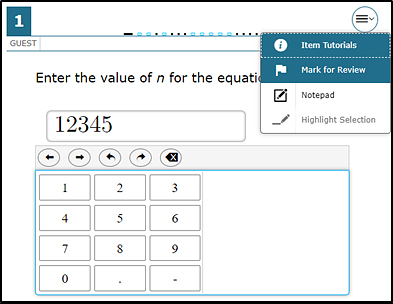
Figure 16. Mark for review
Figure 17 shows three questions (23, 26, and 29) that have been marked for review at the end of a segment. A student may select a question to return to it.
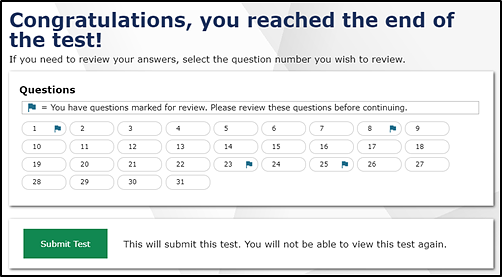
Figure 17. Questions marked for review
Mathematics Tools
Approved Assessment(s):
- Smarter Balanced for Mathematics
- CAST
Description:
These digital resources (for example, embedded ruler, embedded protractor) are used for measurements related to mathematics or science questions. They are available only with the specific questions for which the test item specifications indicate that one or more of these resources would be appropriate.
Science Charts
Approved Assessment(s):
- CAST
Description:
- A student taking the grade eight or high school CAST may refer to a periodic table of elements as a universal tool. A student taking the grade eight or high school CAST may refer to a reference sheet of formulas.
- When the Spanish stacked–dual language designated support has been assigned, the periodic table of the elements is available in Spanish.
- The science chart in figure 18 is the reference sheet that appears for grade eight after the [Formulas] button has been selected.
-
A student can resize a science chart by hovering over the circle with the arrows in the lower-right corner—also indicated in figure 18—until the cursor turns into a diagonal, two-headed arrow; and then using the selection means (for example, pressing and holding a mouse button) to drag the science chart corner to increase or decrease the size of the science chart.
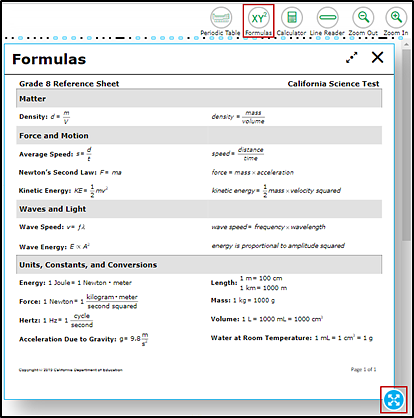
Figure 18. Science charts (formulas reference sheet)
Science Tools
Approved Assessment(s):
- CAST
Description:
A student taking the CAST may use a special embedded resource, if applicable, such as interactive laboratory equipment, videos, a stopwatch tool, or any combination of these to respond to a specific question.
Spanish Glossary
Approved Assessment(s):
- CSA
Description:
Grade- and context-appropriate definitions of specific construct-irrelevant terms are shown in Spanish on the screen via a pop-up window. An example is shown in figure 19.
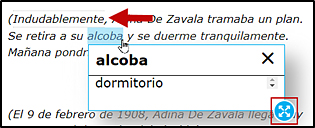
Figure 19. Spanish glossary
- A student can access the embedded glossary by selecting any of the preselected terms, which are identified with light-gray parallel lines above and below the term. When the student hovers over the term—“alcoba” in figure 19—it is shaded blue; it will also have hover text that says “lookup word” (not shown). In figure 19, “Indudablemente” is also a glossary term.
- A student can resize the glossary by hovering over the circle with the arrows in the lower-right corner—indicated in figure 19—until the cursor turns into a diagonal, two-headed arrow; and then using the selection means (for example, pressing and holding a mouse button) to drag the glossary corner to increase or decrease the size of the glossary.
- The use of this universal tool may result in the student needing additional overall time to complete the assessment.
- For mathematics and science, refer to the translation glossaries designated support.
Spell Check
Approved Assessment(s):
- Smarter Balanced for ELA
- Smarter Balanced for Mathematics
- CAST
- CSA
Description:
Spell check is a writing tool for checking the spelling of words in student-generated responses. The [Spell Check] button on the Writing toolbar is indicated in figure 20.

Figure 20. Spell check
- Spell check only gives an indication that a word is misspelled; it does not provide the correct spelling.
- Spell check is bundled with other embedded writing tools for ELA, mathematics, and science items with open-ended student responses.
- This resource is available only with the specific questions for which the test item specifications indicated that it would be appropriate.
Strikethrough
Approved Assessment(s):
- All (computer-based assessments)
Description:
Strikethrough allows a student—alone or with the help of a test examiner (Initial ELPAC, Summative ELPAC K–2, and alternate assessments)—to cross out answer options. If an answer option is an image, a strikethrough line will not appear, but the image will be grayed out. The student selects strikethrough by right-clicking the option and then selecting Strikethrough from the shortcut menu or the context menu (figure 21). Options can be unstricken by selecting Undo Strikethrough.

Figure 21. Strikethrough
Writing Tools
Approved Assessment(s):
- Smarter Balanced for ELA
- Smarter Balanced for Mathematics
- CAST
- Initial ELPAC
- Summative ELPAC
Description:
Selected writing tools are available for all student-generated responses. (Also refer to spell check.) Writing tools are as follows:
- Bold
- Italic
- Underline
- Remove Format
- Numbered
- Bullet
- Outdent
- Indent
- Cut
- Copy
- Paste
- Undo
- Redo
- Spell check (CAASPP only)
- Insert special character
Writing tools on the Writing toolbar are shown in figure 22.

Figure 22. Writing tools
Zoom
Approved Assessment(s):
- All (computer-based assessments)
Description:
Zoom is a resource for making text or other graphics in a window or frame appear larger on the screen. The buttons controlling zoom are indicated in figure 23.
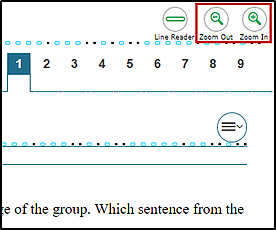
Figure 23. Zoom
- The default font size for all tests is 14 point.
- The student can make text and graphics larger by selecting the [Zoom In] button. The student can select the [Zoom Out] button to return to the default or smaller print size. Zoom levels are shown in table 1.
| Level # | Size |
|---|---|
| Level 0 | No zoom, 14-point text |
| Level 1 | 1.50× zoom |
| Level 2 | 1.75× zoom |
| Level 3 | 2.50× zoom |
| Level 4 | 3.00× zoom |
- When using the zoom feature, the student changes the size of text and graphics on the current screen only, including the size of the navigation buttons. To increase the default print size so that it persists during the entire test (from 1.5× to 3× default size), the print (font) size must be assigned to the student as a test setting in TOMS or set by the test administrator or test examiner prior to the start of the test. This is the only feature that test administrators and test examiners can set.
- The use of this resource may result in the student needing additional overall time to complete the assessment.
- To set the zoom to a size larger than 3× default, refer to the Streamline embedded designated support.
Non-Embedded
Non-embedded universal tools are not embedded within the TDS and are provided by the test administrator or test examiner to students at the time of testing. All accessibility resources for PPTs are non-embedded.
Breaks (Computer-based Assessments, PPTs, and PPT Emergency Forms)
Approved Assessment(s):
- All
Description:
Breaks, including those during testing over more than one day or between the ELPAC domain sections are permitted if the student needs more time to test.
The use of this universal tool may result in the student needing additional overall time to complete the assessment.
English Dictionary (Writing)
Approved Assessment(s):
- Smarter Balanced for ELA (PT)
Description:
An English dictionary can be provided for the full write portion of an ELA PT. (A full write is the second part of a PT.)
The use of this resource may result in the student needing additional overall time to complete the assessment.
English Thesaurus
Approved Assessment(s):
- Smarter Balanced for ELA (PT)
Description:
A thesaurus contains synonyms of terms that can be accessed while a student interacts with text included in the assessment. The use of this universal tool may result in the student needing additional overall time to complete the assessment.
This resource is available only on the for ELA full write (WER) PT. (A full write is the second part of a PT.)
Highlighter
Approved Assessment(s):
- Initial ELPAC (Writing domain for K–2)
- Summative ELPAC (Writing domain for K–2)
Description:
Highlighter is a resource for marking desired text, questions, answers, or parts of these with a colored pen. A student—alone or with the help of a test examiner (Initial ELPAC and Summative ELPAC K–2 Writing)—is permitted to use a highlighter in the Test Book, for example.
Mark for Review (Grade Two)
Approved Assessment(s):
- Initial ELPAC (Writing domain for grade two)
- Summative ELPAC (Writing domain for grade two)
Description:
A student may mark in an assigned Test Book, including noting items for review.
Oral Clarification of Test Directions in English
Approved Assessment(s):
- Initial ELPAC (computer-based assessments)
- Initial ELPAC (Writing domain for K–2)
- Summative ELPAC (computer-based assessments)
- Summative ELPAC (Writing domain for K–2)
- Initial Alternate ELPAC
- Summative Alternate ELPAC
Description:
The test examiner clarifies test directions to a student in English.
Scratch Paper
Approved Assessment(s):
- All
Description:
A student may use blank scratch paper to make notes, write computations, record responses, or create graphic organizers.
- Only plain paper or lined paper is appropriate for ELA and the ELPAC.
- For mathematics, graph paper can be used at all grade levels but is required beginning in grade six.
- A whiteboard with a marker may be used as scratch paper for all assessments.
- As long as the construct being measured is not impacted, assistive technology devices, including low-tech assistive technology (Math Window), are permitted to make notes. The assistive technology device needs to be consistent with the student’s IEP or Section 504 plan.
- Access to the internet must be disabled on assistive technology devices.
CAT and the CAST:
- All scratch paper must be collected and securely destroyed at the end of each ELA and mathematics CAT session and the CAST to maintain test security.
- All notes on whiteboards or assistive technology devices must be erased at the end of each CAT session.
PTs:
- For the mathematics and ELA PT, if a student needs to take the PT in more than one session, scratch paper, graphic organizers, whiteboards, assistive technology devices, or any combination of these may be collected at the end of each session, securely stored, and made available to the student at the next PT testing session.
- Once the student completes the PT, the scratch paper or graphic organizer must be collected and securely destroyed, whiteboards should be erased, and notes on assistive technology devices should be erased to maintain test security.
Test Navigation Assistant
Approved Assessment(s):
- Initial ELPAC (computer-based assessments)
- Summative ELPAC (computer-based assessments)
- Initial Alternate ELPAC
- Summative Alternate ELPAC
Description:
A student who is a new arrival and a student who is unfamiliar with the test delivery device or is a technology novice and does not have the necessary computer skills to participate in the computer-based ELPAC may have a trained test examiner help with mouse point-and-click and scroll bar assistance, on-screen tool or button navigation (for example, back, next, submit, start and stop recording, play speaking, and recording), and keyboarding assistance necessary for starting the test session.
- The test examiner is allowed to assist only with the technology as indicated by the student.
- Test navigation assistant can be used during one-on-one or group administrations.
- The use of keyboarding assistance in the test is not permitted with this universal tool.
Test navigation assistant must follow approved guidelines in the Use Scenarios document.

